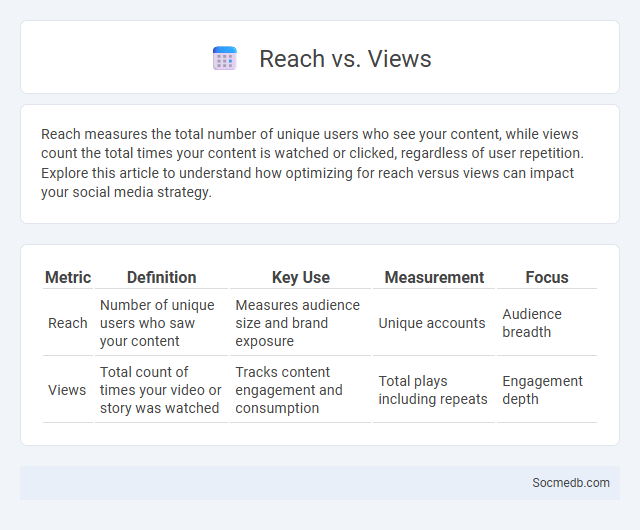
Photo illustration: Reach vs Views
Reach measures the total number of unique users who see your content, while views count the total times your content is watched or clicked, regardless of user repetition. Explore this article to understand how optimizing for reach versus views can impact your social media strategy.
Table of Comparison
| Metric | Definition | Key Use | Measurement | Focus |
|---|---|---|---|---|
| Reach | Number of unique users who saw your content | Measures audience size and brand exposure | Unique accounts | Audience breadth |
| Views | Total count of times your video or story was watched | Tracks content engagement and consumption | Total plays including repeats | Engagement depth |
Understanding the Difference: Reach vs Views
Reach refers to the total number of unique users who have seen your social media content, while views count the total number of times your content is watched or engaged with, including multiple views from the same user. Understanding the difference between reach and views helps you evaluate your audience size versus engagement depth, enabling you to tailor your marketing strategies more effectively. By focusing on both metrics, you can optimize your content to maximize Your impact across social media platforms.
What Is Reach? Exploring Its Definition
Reach in social media refers to the total number of unique users who see your content, providing a measure of your brand's visibility and potential audience size. It differs from impressions, which count the total views, as reach specifically tracks individual users who have encountered your posts. Understanding reach helps you gauge the effectiveness of your content strategy and optimize efforts to expand your audience engagement.
The Concept of Views: What Does It Mean?
Views on social media represent the number of times a piece of content, such as videos or stories, is watched or displayed to users, serving as a key metric for measuring audience engagement and reach. Platforms like YouTube, Instagram, and TikTok track views differently, often counting a view after a user watches a video for a specific minimum duration, ensuring genuine interest is captured. Understanding the concept of views helps marketers and creators analyze content performance, optimize strategies, and increase visibility across digital channels.
Why Reach and Views Matter in Digital Marketing
Reach and views directly influence brand visibility and audience engagement, key drivers in digital marketing success. Higher reach expands the potential customer base, while increased views signal content relevance and help boost search engine rankings. Measuring these metrics allows marketers to optimize campaigns, allocate budgets effectively, and improve return on investment (ROI).
Key Metrics: How to Measure Reach and Views
Tracking social media key metrics like reach and views is essential for understanding your content's performance and audience engagement. Reach quantifies the unique number of users exposed to your content, while views indicate how many times your content has been watched or interacted with. Monitoring these metrics helps you optimize your strategy, ensuring your social media efforts effectively grow your brand visibility.
Reach vs Views: Common Misconceptions
Reach often gets confused with views, but these metrics measure different aspects of social media performance. Reach refers to the total number of unique users who see your content, while views count the total number of times the content is watched, often multiple times by the same user. Understanding this distinction helps you accurately assess Your audience engagement and optimize content strategy effectively.
Impact of Reach and Views on Campaign Performance
High reach and extensive views significantly enhance your campaign performance by increasing brand visibility and audience engagement. Social media algorithms prioritize content with higher interaction rates, boosting organic reach and driving more potential conversions. Monitoring these metrics allows precise optimization, ensuring campaigns deliver maximum impact and return on investment.
Optimizing Content for Maximum Reach and Views
Optimizing content for maximum reach and views on social media involves using relevant keywords, engaging visuals, and posting at peak times based on audience analytics. Tailoring captions with strategic hashtags and clear calls-to-action boosts your content's visibility across platforms such as Instagram, Facebook, and TikTok. You can significantly enhance engagement by analyzing performance metrics and continuously refining your content strategy accordingly.
Analyzing Reach and Views in Social Media Platforms
Analyzing reach and views in social media platforms provides critical insights into content performance and audience engagement. Metrics such as unique impressions, total views, and viewer demographics help you understand how widely your message spreads and who interacts with it. Leveraging these data points allows for more targeted strategies to maximize visibility and optimize content for higher engagement rates.
Best Practices for Balancing Reach and Views
Optimizing your social media strategy requires balancing reach and views by targeting quality content to your audience's preferences and posting at peak engagement times. Utilizing analytics tools helps identify which formats and topics generate the most views without sacrificing the overall reach of your profile. You should focus on creating compelling visuals and concise messaging that encourages interaction while ensuring content distribution across multiple platforms for maximum visibility.
 socmedb.com
socmedb.com